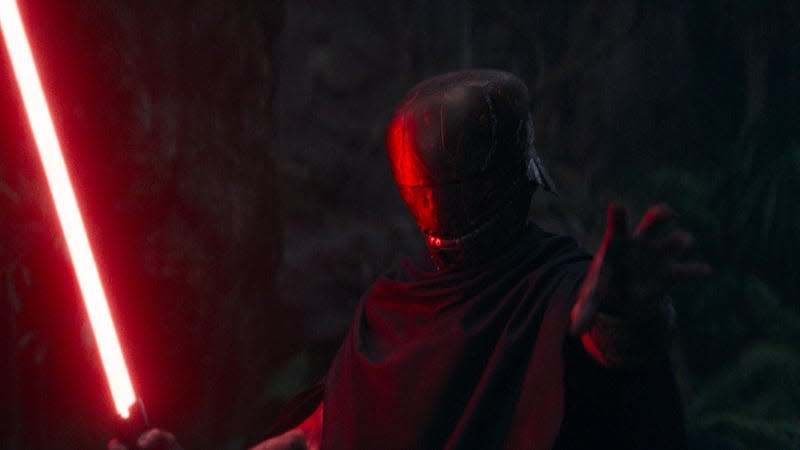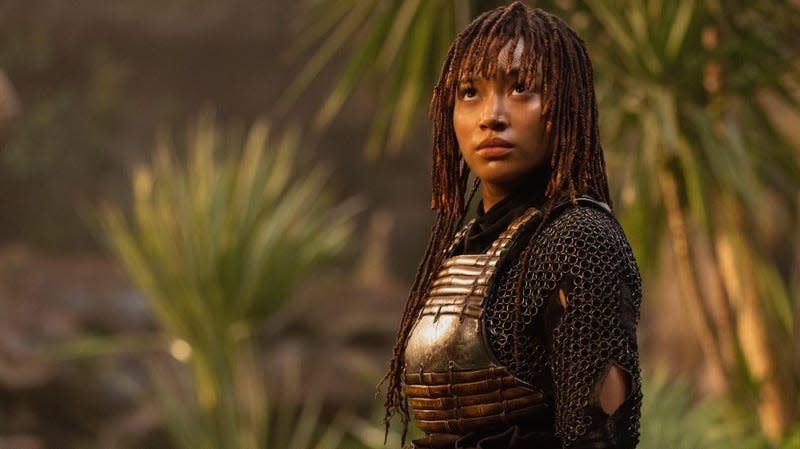The Acolyte's Fourth Episode Is A Mundane Misstep

After establishing a high bar in earlier episodes, The Acolyte’s fourth installment struggles to maintain the momentum, suffering from a mix of standard writing, camerawork, and performances. Unfortunately, it also exhibits a number of tropes that are causing the Hollywood machine distress industry wide.
Episode 4 is centered around two opposing parties racing to be the first to find Jedi Master Kelnacca (Joonas Suotamo). The Acolytes want to find him for the kill to complete a mission from their mysterious master, and the Jedi want to get to him before it’s too late. Twin sisters Osha and Mae (both played by Amandla Sternberg) are on opposing sides, struggling with their connection to each other—Osha sure that she can’t hurt her own sister, and Mae contemplating with whom her loyalties truly lie. Without spoiling it for you, we get a glimpse of the Acolytes’ mysterious master at the end of the episode, who looks pretty cool, teasing a battle with the Jedi. It’s an abrupt cliffhanger to a mostly statically paced episode.
What makes this episode feel static? Sometimes when watching a show, I like to close my eyes and just listen. Listen for the rhythm of the dialogue, what’s being said, and how it’s being said. Listen for when the music comes in and out. If it sounds like another film or show, in my view, it’s on the path to lacking potency. That can translate into a film or show feeling old, slow, or unoriginal. This was the first episode of The Acolyte that struck me this way: as an episode packed with generic scene pacing and dialogue beats.
I challenge you to find these recycled scene patterns for yourself across this episode of The Acolyte. Here’s a few to start you off:
The standard shots and pacing of the dialogue between Jedi Masters Sol (Lee Jung-jae) and Vernestra (Rebecca Henderson)
The sonic device of Jedi Knight Yord (Charlie Barnett) clearing his throat to interrupt Osha’s whispers to Jedi Padawan (an “apprentice”) Jecki Lon (Dafne María Keen Fernández) about the cute new tracker character, Bazil
The performance rhythm of Osha asking Yord to stop Mae in the event she won’t join the Jedi side
We have all seen these type of scene structures before in other films and shows. Close you eyes and feel the mundane Force.
It’s important to note that the seeds for this lack of uniqueness were planted in earlier episodes and films. We can at least trace this back to Finn calling Imperial personnel “cops” in The Last Jedi as he tries to avoid them when infiltrating their ship. In The Acolyte, the Jedi act as law enforcement, and their use of language references modern TV police, with Yord telling Mae to come out of Kelnacca’s home with her hands where they can see them. I don’t watch Star Wars to remember our current way of life in the real world, I watch it to be inspired to think differently. I wish the approach to these characters and systems satisfied my craving.

Still, this episode is not without its gems. The most impactful moment for is a sequence in which Osha unwittingly touches a giant bug (an “umbramoth”) and it attacks her. Jedi Master Sol kills the umbramoth to save her, which is an interesting choice given that I would assume a Jedi could calm the creature down without violence. Remorseful Osha then speaks to Jedi Padawan Jecki Lon, who delivers one of the most powerful lines in the series so far, “It’s always an honor to get to witness anything or anyone transform into the force.” When ideas like this are shared, they deserve contemplation from the audience.
Overall, this episode has a lot of uninspired talking with basic shot/counter-shot coverage of dialogue, and a slow pace. I had excitement going into it because of Master Kelnacca, a Wookiee that I’ve truly been looking forward to getting to know given that the Star Wars films have undervalued the character Chewbacca to the point of near in-universe racism. (Yes, I’m still upset the Wookiee didn’t get a medal at the end of A New Hope.) By the end of the episode, I’m reminded the framing of Wookiees in Star Wars is part of the system of tropes that kept this episode from living up to the rest. Let’s hope all of this changes in episode 5.


